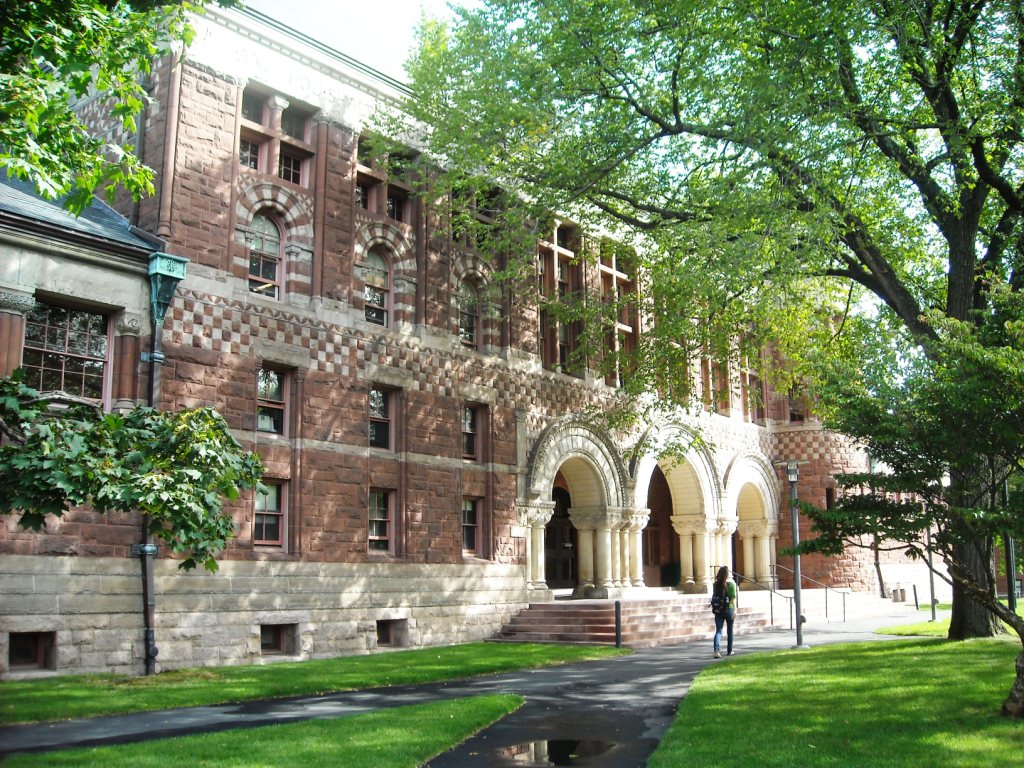A Summary of ICE’s Reversal and Re-reversal on Online Class Policy for International Students
The Department of Homeland Security announced a policy that would force international students to leave the country or transfer if their universities went fully online. A week later, the rule was rescinded. What happened?

Published by The Lawfare Institute
in Cooperation With

The much anticipated July 14 hearing in the Harvard/MIT lawsuit over Immigration and Customs Enforcement’s new international student policy in the age of online learning ended, to the relief of many, with an about-face. The U.S. Department of Homeland Security decided to rescind its July 6 announcement of a policy that would have required international students to leave the United States or transfer to a different university if their course load remained entirely online and would also prevent visas from being issued for students completing coursework solely online.
U.S. District Judge Allison D. Burroughs noted that the government’s reversal moots the matter, but she is keeping it on her docket pending further motions from the parties.
The time between the Department of Homeland Security’s July 6 announcement and its rescission eight days later saw a whirlwind of action. With the fall 2020 term on the horizon, parties had little time to waste. While the issue seems “settled” for now, the department may improve its rulemaking posture and attempt a similar policy change in the future. Below we chronicle the major developments and briefly discuss possible next steps.
How Did the Controversy Begin?
On July 6, Homeland Security announced that international students on an F-1 or M-1 visa could not remain in the United States if their full course load is online. Under the new policy, the department would not issue new visas and active students currently in the United States would have had to depart or transfer to a school with in-person instruction. Failure to do so could have led to removal proceedings. This policy was a rollback of the exemption the government granted back in March, which permitted students to remain in the United States even if their universities transitioned to an all-online format.
Immigration and Customs Enforcement (ICE) manages international students through the Student and Exchange Visitor Program (SEVP). Specifically, SEVP oversees students and dependents in the F (academic) and M (vocational) visa categories. F-1 visas are for the student, F-2 for their dependents, and F-3 for Canadian or Mexican commuter students. The M visas are similarly categorized. To keep their status, F-1 and M-1 visa holders typically have to be pursuing a full course of study.
Normally, a student on an F-1 visa cannot count more than one class or three-credit equivalent per term of online instruction toward their full course of study requirement (8 C.F.R. 214.2(f)(6)(i)(G)), students on M-1 visas cannot count any online classes toward their course of study (8 C.F.R. 214.2(m)(9)(v)). However, with the growing concerns surrounding the novel coronavirus, many universities transitioned to partial or full online instruction. Homeland Security allowed international students to temporarily count online classes toward a full course of study in excess of the regulatory limits. The department noted that “[t]his temporary provision is only in effect for the duration of the emergency and in accordance with the procedural change documents filed in a timely manner to SEVP.”
However, with the fall semester only a little more than a month away, the department decided to limit the exemptions for online learning. Suits followed soon after.
Universities, States and Students Sue
On July 8, Harvard University and the Massachusetts Institute of Technology (MIT) filed pleadings in the U.S. District Court for the District of Massachusetts in Boston. In addition, the Los Angeles public interest law firm Public Counsel, with pro bono help from Sidley Austin, filed suit in the U.S. District Court for the Central District of California on behalf of international students.
The Harvard/MIT complaint first explained how damaging the coronavirus had been to all communities in Massachusetts. In light of this emergency, on March 13, ICE had permitted students enrolled in U.S. universities to attend only remote classes and keep their visas, as opposed to the past policy where the majority of students’ classes had to be in person. ICE stipulated that the exemption was “in effect for the duration of the emergency.” Harvard and MIT noted that, as the emergency continued, both universities made the decision for the sake of safety that most of the students would need to attend remote classes in the fall.
The pleadings then took issue with the manner of the ICE directive. ICE announced the directive right after July 4, and gave universities only nine days to announce how they would comply with the new regulation. Additionally, the policy left thousands of international students with no real option for education in the United States just weeks before the start of the fall semester. Students who had to return to their home countries would encounter severe obstacles in continuing their education. For example, students from Asia would be in a different time zone that might require them to be awake at 3:00 a.m. or later to attend online classes in real time. Furthermore, the complaint alleged, the Homeland Security policy did not take into account the months of planning that the universities put in to ensure safety for their students and employees. The pleadings alleged that the whole order was nothing more than a ploy to force the schools to hold classes in person in the fall.
The complaint included several other claims. First, it alleged that the directive violated the Administrative Procedure Act, 5 U.S.C. § 706 (APA) because it was “arbitrary and capricious” since it did not take into account the devastating impact the policy would have on the health and safety of all members of the schools’ communities. Additionally, it would upend planning on the part of both the universities and their international students, who had “serious reliance interests” based on planning around ICE’s previous directive.
The pleadings also argued that the directive violated the APA because ICE did not provide any “reasoned basis that could justify the policy.” In the case Motor Vehicle Mfrs. Ass’n of United States, Inc. v. State Farm Mut. Auto. Ins. Co., the Supreme Court found that the agency providing the directive must “cogently explain why it has exercised its discretion in a given manner.” ICE failed to provide any rationale for its decision in light of the negative impacts from this directive.
Harvard and MIT also argued that the directive did not abide by the required notice-and-comment rulemaking procedure. Section 553 of the APA requires that before a “rule” takes effect, the public must be given the opportunity to comment on the rule. The pleadings alleged that the directive fit the definition of the rule provided by Section 551(4) of the APA, which defines a rule as an “agency statement of general or particular applicability and future effect designed to implement, interpret, or prescribe law or policy.” Harvard and MIT maintained that the directive was a “rule” because of the substantive change in policy it created for the universities and students. The only way that ICE could be exempt from this requirement would be if ICE provided “good cause” for not providing a notice-and-comment period, which it had failed to do.
The pleadings had five requests for relief: a “temporary restraining order and preliminary and permanent injunctive relief,” so that Harvard and MIT would not have to enforce ICE’s directive; an order for ICE to vacate its announced directive and reinstate its previous guidance; a “declaration” that ICE’s directive was “unlawful”; a request for plaintiff costs and fees; and “other such relief as the Court may deem appropriate.”
A coalition of 180 colleges and universities known as the Presidents’ Alliance on Higher Education and Immigration filed an amicus brief supporting the Harvard/MIT lawsuit. Moreover, a coalition of 59 other colleges and universities, including all the other Ivy League schools, filed an amicus brief. Many leading technology companies such as Google also filed an amicus brief.
In addition to universities challenging the directive, 17 states led by Massachusetts filed a lawsuit. Like the Harvard/MIT lawsuit, it was filed in the Massachusetts federal district court in Boston. The states’ lawsuit included many of the same complaints as the Harvard/MIT lawsuit. The main difference was that their lawsuit shared how the directive would negatively impact the state governments’ abilities to keep all their citizens safe.
There were seven additional lawsuits. Four lawsuits were filed, respectively, in Washington, D.C., Oregon, New York, and Washington state; and three were filed in California, including the Public Counsel lawsuit described above. These seven lawsuits were pursued largely by universities, as well as some students, based in the regions that those courts had jurisdictions. The only substantial difference among the lawsuits was that the Oregon lawsuit sought expedited discovery on the basis that the reasons for the directive were “pretextual” and contradicted the given reason for the directive by ICE, because—the suit alleged—the administration wanted to use the directive to force universities to open with in-person classes. The Oregon lawsuit referred to remarks that Acting Deputy Secretary of Homeland Security Ken Cuccinelli made on CNN that the rule was meant to “encourage schools to reopen,” and argued that Cuccinelli’s comments coupled with Trump’s tweets on reopening schools made it clear the directive was part of Trump’s agenda to reopen schools. The Oregon lawsuit argued that, based on Dep’t of Commerce v. New York, this was a violation of Section 706(2)(A) of the APA because the decision was not made carefully, balancing the considerations but, instead, that the department had prejudged the issue and made a decision before considering the relevant factors.
The Initial Government Response
In opposition to the Harvard/MIT motion for a temporary restraining order and request for preliminary injunction, the Department of Homeland Security relied on the discretionary nature of the initial exemption granted back in March. The department noted in its brief:
The regulation explicitly excludes 100% online course loads. Petitioners do not argue ICE should revert to the black letter of the regulation, but instead contest ICE’s discretionary decision to temporarily adjust its enforcement posture while [the] nation is in the grips of the COVID-19 pandemic. The July 6 policy announcement is nothing more than a reminder that students must depart should they violate the terms of their nonimmigrant student visa.
The department claimed that the Harvard/MIT motion “seeks to freeze a single policy decision in time,” preventing the agency from responding to new developments surrounding the coronavirus.
To receive a preliminary injunction, had ICE not rescinded the policy, Harvard and MIT would have had to demonstrate a substantial likelihood of success on the merits of their claim. Homeland Security asserted that Harvard and MIT were unlikely to succeed on the merits because ICE’s decisions “were not arbitrary or capricious and were made after considering important aspects of the problem before the agency.” The department pointed to a statement that accompanied all “Frequently Asked Questions for SEVP Stakeholders about COVID-19” documents posted on its site:
Note: SEVP [Student and Exchange Visitor Program] continues to actively monitor COVID-19 and provide up-to-date information to stakeholders, including designated school officials (DSOs) and F and M students. Due to the fluid nature of this situation, the answers in this document may be subject to change. Refer to ICE.gov/COVID19 for the most up-to-date version of this FAQ.
Homeland Security claimed this alone demonstrates ICE considered at least two important aspects of the coronavirus’s impact: the fluid nature of the pandemic and the need for stakeholders to have access to guidance regarding the pandemic’s impact. The department also claimed that permitting international students to exceed regulatory limits on counting online courses toward a full course of study for schools employing a hybrid approach showed that ICE considered and balanced the equities of the parties involved. The department also stressed that any further reliance interests that schools may have had from the March guidance were inconsequential because it was clear that guidance was temporary. In other words, the schools could not argue any further dependence on the March guidance because it was clearly an interim measure. Schools and students are required to be aware of obligations and restrictions under federal regulations.
In addition, Homeland Security argued that the new rule was supported by a reasoned basis and justification. The department pointed to ICE statements concerning the need to balance protections implemented by federal regulations and strike a balance between providing schools with flexibility and minimizing further risk of coronavirus transmission from new arrivals. Under the APA, the department was empowered to balance these factors based on its own deliberations, even if Harvard and MIT disagreed with its rationale.
Furthermore, Homeland Security asserted that it was not required to have a notice-and-comment period because the July 6 announcement was at most a “statement of policy.” Under the APA, such general statements of policy are excepted from notice-and-comment requirements. Rather, said the department, the July 6 announcement was meant only to provide advance notice that the department would publish a forthcoming revised policy in the Federal Register. Homeland Security asserted that “[n]othing in the July 6 policy announcement itself requires ICE to take administrative compliance actions against schools that do not complete reporting in accordance with the deadlines laid out.”
Pointing to the March exemptions, the Department of Homeland Security (DHS) noted:
Implicit in Plaintiffs’ argument here is the contention that DHS’s March 2020 announcement was a modification of federal regulations that could only be subsequently modified through the APA’s notice-and-comment process. Yet, the July 6 policy announcement has no legal effect and establishes no such binding norms. DHS’s March 2020 announcement was issued as a function of DHS’s “absolute discretion” to decline to bring enforcement actions against F-1 students and certified schools who would have been operating in violation of the federal regulations when shifting to a fully online instruction model in light of the COVID-19 emergency.
Therefore the July 6 message did not change federal regulations, the department said. Rather, it announced the actual “procedures and responsibilities” comprising the change that would be published in the near future as a Temporary Final Rule.
Homeland Security also argued that Harvard and MIT had failed to show they would suffer irreparable harm in the absence of an injunction. The new policy did not require universities to cease providing online learning. The department also claimed that Harvard and MIT had failed to explain how a lack of presence of international students in the United States would negatively affect other students under an online-only format. The department questioned how Harvard and MIT could claim there was a correlation between a physical presence in the United States and the quality of education if the schools are requiring the majority of the other students to participate in online classes.
Homeland Security went on to state that a temporary restraining order would actually irreparably harm the United States and the public. The public has an interest in the government enforcing immigration laws in accordance with statutes.
Lastly, Homeland Security challenged Harvard and MIT on their standing to bring suit. In the U.S. Court of Appeals for the First Circuit, litigants asserting third-party standing, in this case filing a lawsuit asserting the rights of another, have to demonstrate:
[First] that the litigant personally has suffered an injury in fact that gives rise to a sufficiently concrete interest in the adjudication of the third party’s rights; [second] that the litigant has a close relationship to the third party; and [third], that some hindrance exists that prevents the third party from protecting its own interests. Council of Ins. Agents & Brokers v. Juarbe–Jimenez, 443 F.3d 103, 108 (1st Cir.2006) (internal quotations omitted).
Homeland Security argued that the only specific harms Harvard and MIT had alleged were speculative and “relate[d] to the desire to implement additional in-person classes and an alleged loss to the diversity of their student body.” Furthermore, the schools did not specify an international student who suffered an injury-in-fact and who is hindered from protecting their own interests. Additionally, the department argued that Harvard and MIT “make no attempt to demonstrate a ‘close relationship’ between the school and any nonimmigrant student to satisfy the requirements for third-party standing.”
The Way Ahead
Even though the initial ICE directive was rescinded, there are indications that Homeland Security will issue a regulation concerning international students and online learning in the coming weeks. While no specifics have been released, the department could differentiate between international students already in the United States and those entering for the first time.
The content and effective date of any such new regulation is unknown at present. Homeland Security could improve its procedural posture by opting for a notice-and-comment period for a rule change that would be implemented in the future. Of course, submitting a proposed new rule for notice and comment would entail significant delays in implementing the policy, since notice and comment could take at least six to eight months to complete. That delay would allow current F-1 visa-holders to remain in the United States for the fall semester and permit new students to enter the United States for the upcoming academic year. Moreover, a notice-and-comment period could delay the new rule until after January 2021, when a new president might take office, depending on the results of the November election. Regardless, any policy that seeks to limit student visas based on a school’s online-learning policy in the age of the coronavirus would likely face opposition from universities across the United States.




.jpg?sfvrsn=676ddf0d_7)

